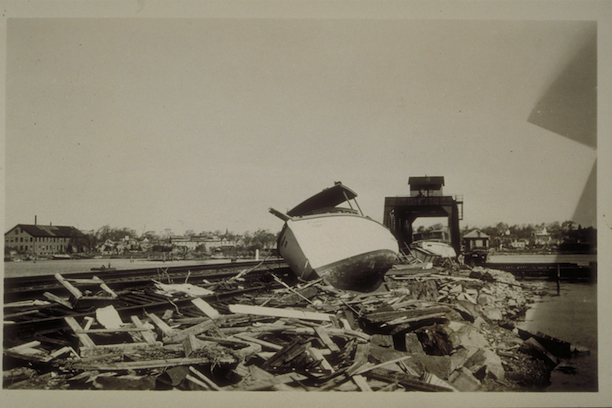By Patrick J. Mahoney
In September 1944, ongoing news of World War II gripped headlines across the United States. On eastern shores, coast watchers and residents remained vigilant in their lookout for German U-boat activity. But as residents kept their eyes on the seas, a different type of threat actually bore down on them. The Hurricane of 1944, often referred to as the “Great Atlantic Hurricane,” swept across the eastern seaboard of the United States, leaving mass destruction in its wake. While the Category 3 storm lasted only eight days (from September 9 to September 16) the damage it left behind was in excess of $100 million.

Boats on railroad bridge, Mystic, 1938 hurricane – Mystic Seaport
Remembering the Hurricane of 1938

Southern New England Telephone Company switchboard operators, Hurricane 1944, New Haven, Connecticut – Archives & Special Collections at the Thomas J. Dodd Research Center, University of Connecticut Libraries
As the hurricane moved up the East Coast toward Connecticut in early September, most residents thought back to the devastation wrought by the Hurricane of 1938. On September 14, 1944, as updates from the United States Weather Bureau poured in, state officials made extensive preparations for the impending storm. The Hartford Courant acknowledged the expansive nature of this work and its stark contrast with the preparations for the hurricane that struck just six years earlier.
Among the measures undertaken were the assembling of the Civil Defense Organization of the State War Council and the establishment of a storm headquarters at the office of Hartford Mayor William H. Mortensen. Additionally, state officials activated the War Emergency Radio Service (the first time they used it for anything other than a routine test) and evacuated residents and vacationers from shoreline areas. Furthermore, Governor Raymond Baldwin requested all police and fire departments, as well as medical personnel, be prepared for service as first responders.
The 1944 Hurricane Hits Connecticut
When the worst of the storm arrived on the night of Thursday, September 14, Hartford received over 7 inches of rain and wind gusts up to 109 miles per hour, while coastal areas struggled under as much as 11 inches of precipitation. A small number of Connecticut residents lost their lives and the state suffered $2 million in losses to its tobacco and fruit crops, but the heightened nature of pre-storm preparation and a low storm surge fortunately limited damages.

Great Atlantic Hurricane clean up, 1944, Lyme, Connecticut – Southern New England Telephone Company Records, Archives & Special Collections at the Thomas J. Dodd Research Center, University of Connecticut Libraries
Additionally, while the state’s booming tobacco industry initially reported substantial losses, subsequent reports indicate that the early estimates proved excessive, and that by year’s end, the heavy rains provided some benefit to the crops in what was otherwise an unusually dry season. At the end of September, the Water Resources Branch of the US Department of the Interior Geological Survey noted in their monthly report of Connecticut that “the heavy rains which fell during the week of the hurricane effectively relieved, for the time being at least, the acute drought conditions which prevailed in the area.”
While the 1944 hurricane never displayed the ferocity of the 1938 storm, it still served as a test of Connecticut’s progress in improving upon its emergency response systems. Residents lost their lives, both on land and on the sea, and the state spent millions of dollars rebuilding in the wake of the storm, but fortunately for Connecticut residents, the reported numbers proved a mere fraction of the losses sustained six years earlier.
Patrick J. Mahoney is a Research Fellow in History & Culture at Drew University and former Fulbright scholar at the National University of Ireland Galway









